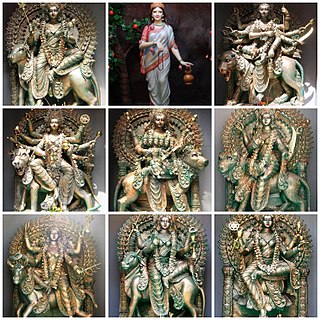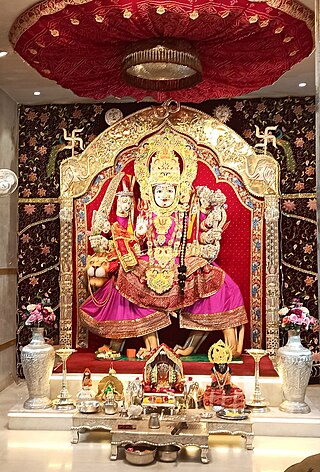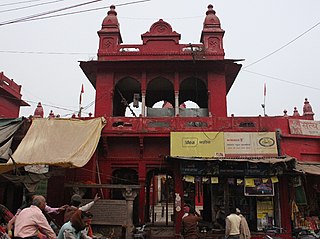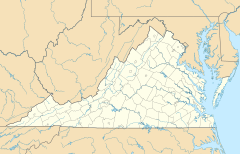Hinduism is an Indian religion or dharma, a religious and universal order or way of life by which followers abide. The word Hindu is an exonym, and while Hinduism has been called the oldest religion in the world, it has also been described as sanātana dharma, a modern usage, based on the belief that its origins lie beyond human history, as revealed in the Hindu texts. Another endonym for Hinduism is Vaidika dharma.

Lakshmi also known as Shri, is one of the principal goddesses in Hinduism. She is the goddess of wealth, fortune, power, beauty, fertility and prosperity, and associated with Maya ("Illusion"). Along with Parvati and Saraswati, she forms the Tridevi of Hindu goddesses.

Durga is a major Hindu goddess, worshipped as a principal aspect of the mother goddess Mahadevi. She is associated with protection, strength, motherhood, destruction, and wars.

Hinduism in Southeast Asia had a profound impact on the region's cultural development and its history. As the Indic scripts were introduced from India, people of Southeast Asia entered the historical period by producing their earliest inscriptions around the 1st to 5th century CE. Today, Hindus in Southeast Asia are mainly Overseas Indians and Balinese. There are also Javanese and Balamon Cham minority in Cambodia and south central Vietnam who also practice Hinduism.

Vijayadashami, also known as Dussehra, Dasara or Dashain, is a major Hindu festival celebrated every year at the end of Durga Puja and Navaratri. It is observed on the tenth day of the month of Ashvin, the seventh in the Hindu Luni-Solar Calendar. The festival typically falls in the Gregorian calendar months of September and October.

Shaktism is one of the several major Hindu denominations wherein the metaphysical reality, or the godhead, is considered metaphorically to be a woman.

Mahishasura is a bovine asura in Hinduism. He is depicted in Hindu literature as a deceitful demon who pursued his evil ways by shape-shifting. Mahishasura was the son of the asura Rambha and a she-buffalo named Mahisi. He was ultimately killed by the goddess Durga with her trishula (trident) after which she gained the epithet Mahishasuramardini.

Durga Puja, also known as Durgotsava or Sharodotsav, is an annual Hindu festival originating in the Indian subcontinent which reveres and pays homage to the Hindu goddess Durga, and is also celebrated because of Durga's victory over Mahishasura. It is celebrated all over the world by the Hindu community, but it is particularly popular and traditionally celebrated in the Indian state of West Bengal, and other states like Bihar, Assam, Tripura, Odisha, Jharkhand, Uttar Pradesh and some other countries like Bangladesh and Nepal. The festival is observed in the Indian calendar in the month of Ashvin, which corresponds to September–October in the Gregorian calendar. Durga Puja is a ten-day festival, of which the last five are of the most significance. The puja is performed in homes and public, the latter featuring a temporary stage and structural decorations. The festival is also marked by scripture recitations, performance arts, revelry, gift-giving, family visits, feasting, and public processions called a melā. Durga Puja is an important festival in the Shaktism tradition of Hinduism. Durga Puja in Kolkata has been inscribed on the intangible cultural heritage list of UNESCO in December 2021.

Hinduism is a third largest religion in Australia consisting of more than 684,002 followers, making up 2.7% of the population as of the 2021 census. Hinduism is the fastest growing religion in Australia mostly through immigration. Hinduism is also one of the most youthful religions in Australia, with 34% and 66% of Hindus being under the age of 14 and 34 respectively.

Navadurga, also spelled Navdurga and Navadurgas, are nine manifestations and forms of Durga in Hinduism, especially worshipped during Navaratri and Durga Puja. They are often considered collectively as a single deity, mainly among the followers of Shaktism and Shaivism sect of Hinduism.
Anti-Hindu sentiment, sometimes also referred to as Hinduphobia, is a negative perception, sentiment or actions against the practitioners of Hinduism. It exists in many contexts in many countries, often due to historical conflict. There is also scholarly debate on what constitutes Hinduphobia in the Western World.

Hinduism is the second largest religious affiliation in Bhutan, covering about 11.3%% of the population, according to the Pew Research Center 2010. It is followed mainly by the ethnic Lhotshampa. The Shaivite, Vaishnavite, Shakta, Ganapathi, Puranic, and Vedic schools are represented among Hindus. Hindu temples exist in southern Bhutan, and Hindus practice their religion in small- to medium-sized groups. About 84.3% of the population of Bhutan are Buddhist.

Hinduism is the largest religious tradition in the Indian state of West Bengal with approximately 68% of the population identifying themselves as Hindus. The Hindus in West Bengal mostly belong to the Shakta, minority to Vaishnavite and a small community belong to Shaivite and other denominations. The vast majority of Hindus in West Bengal are Bengali Hindus numbering around 55 million and comprising 60.2% of the state population of 91.35 million (2011) but a notable section of non-Bengali Hindus also exist, particularly among Marwaris, Biharis, Odias, Gurkhas, Sindhis, Gujaratis and various tribal communities such as Koch, Santals, Munda and particularly Adivadis numbering around 9.4 million comprising rest 10.3% of the state population. Hindus have decreased in west bengal due to conversion to Islam which National Commission for Backward Classess(NCBC) notices.

Navaratri is an annual Hindu festival observed in honour of the goddess Durga, an aspect of Adi Parashakti, the supreme goddess. It spans over nine nights, first in the month of Chaitra, and again in the month of Ashvin (September–October). It is observed for different reasons and celebrated differently in various parts of the Hindu Indian cultural sphere. Theoretically, there are four seasonal Navaratri. However, in practice, it is the post-monsoon autumn festival called Sharada Navaratri.

Yogamaya, also venerated as Vindhyavasini, Mahamaya, and Ekanamsha, is a Hindu goddess.
Hinduism and Judaism are among the oldest existing religions in the world. The two share some similarities and interactions throughout both the ancient and modern worlds.

Hindu Heritage Centre is a Hindu temple and a Hindu Community Centre located in the city of Mississauga, Ontario, in the Streetsville neighbourhood. The 25 000 square feet temple serves Hindus from the Greater Toronto Area and is considered to be one of the largest Hindu temples in Canada. It features a 10,000 square foot prayer hall, 16 classrooms where daily meditations and scripture teachings are also offered, as are classes in Indian languages, Hindu music and dance, Hindu culture, yoga, and social programs for seniors, and a 9,000 square foot banquet hall also exists for cultural events.

Bhelupur is a suburban neighbourhood located in south of Varanasi district. It is situated 2.5 kilometres west of Kedar ghat and to the river Ganges. Benaras Hindu University is situated 4.5 kilometres south of Bhelupur.

Durga Mandir, also known as Durga Kund Mandir and Durga Temple, is one of the most famous temples in the holy city of Varanasi. This temple has great religious importance in Hinduism and is dedicated to the Maa Durga. Durga Mandir was constructed in 18th century by Rani Bhabani of Natore.

Vaishno Devi Temple, also referred to as Shri Mata Vaishno Devi Temple and Vaishno Devi Bhavan, is a Hindu temple dedicated to goddess Vaishno Devi, one of the major forms of the supreme goddess Durga. It is located in Katra, Reasi on the slopes of Trikuta Hills within the union territory of Jammu & Kashmir in India. Shakta traditions consider the temple as one of the 52 Maha (major) Shakti Peethas dedicated to Durga. The temple is governed by the Shri Mata Vaishno Devi Shrine Board (SMVDSB), chaired by the Government of Jammu and Kashmir in August 1986.



















